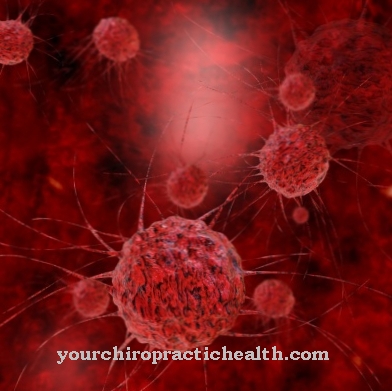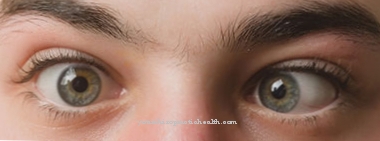A Kyphosis is an outwardly curved (convex) curvature of areas of the spine. There is natural kyphosis in her breast and in the end area. The convex curvature of the spine only becomes pathological if it occurs in an atypical location or if the Cobb angle is no longer within the normal range.
What is kyphosis?

© PIC4U - stock.adobe.com
A convex (outwardly curved) curve of the spine is called a Kyphosis designated. For the stability of the entire spine, the natural kyphosis of the thoracic and end spine and the natural lordosis (curved inwards) of the lumbar spine are necessary. Kyphosis only becomes pathological if it occurs in an atypical location or if it significantly exceeds the natural curvature. If the kyphosis of the thoracic spine is pathologically increased, it is referred to as hyperkyphosis or colloquially as a hump.
In Latin it says Gibbus. The so-called Cobb angle serves as a measure for assessing kyphosis. The normal range is between 30 and 50 degrees. The lumbar spine can atypically also be affected by kyphosis. Usually it is concave (inward). In the case of pathological changes, a flat back or, in extreme cases, even kyphosis of the lumbar spine is possible.
causes
The causes of pathological kyphosis are usually poor posture. During evolution, the human spine had to adapt to upright gait over the past 5 million years. It seems that this process is not yet fully completed. The spine is not yet stable enough to rule out extreme curvatures during development. Therefore, kyphosis that goes beyond the measure is more prevalent among today's population.
In the industrialized countries in particular, kyphosis is exacerbated by frequent sedentary work. Postural kyphosis, which often arises from poor posture in adolescence, is the most common form of kyphosis. In old age, it is known as a widow's hump and is the result of vertebral fractures or the loss of musculoskeletal integrity. Another possible cause is Scheuermann's disease.Scheuermann's disease is an incorrect development of adaptation during puberty. A growth spurt takes place at puberty.
If the dorsal vertebrae are poorly stressed when the muscles are weak, the vertebral bodies grow unevenly. The outer part of the vertebral bodies grows faster than the inner part, so that they become wedge-shaped. An extreme curvature of the spine develops in the chest area.
There are also congenital forms of kyphosis. The vertebral bodies can be deformed or have grown together. Sometimes congenital kyphosis does not appear until teenage years. Diet-related kyphosis is also possible with a vitamin D deficiency. Kyphosis also occurs as a result of tuberculosis or vertebral fractures that have not healed after accidents.
Symptoms, ailments & signs
Kyphosis is manifested by an excessive convex curvature of certain areas of the spine. In many cases the curvatures do not cause discomfort. However, they must be monitored and treated conservatively. Sometimes, however, there is severe pain, breathing problems, problems with digestion, cardiovascular disorders, neurological problems or even neurological failures in the form of paralysis.
Overall, life expectancy is reduced in the extreme forms of kyphosis. Possible long-term consequences include chronic pain with sleep disorders, destruction of the vertebral bodies, impairment of the internal organs, sensory disorders, damage to the spinal cord up to paralysis, reduced mobility or psychological stress due to the disfigurement.
Diagnosis & course of disease
Imaging methods such as spinal column recordings, CT or MRI are available to diagnose the causes of kyphosis. The Cobb angle can be determined on lateral x-rays. These procedures allow signs of old fractures to be identified. However, the anamnesis of the medical history plays an important role in the diagnosis, in order to be able to differentiate between postural damage and organic causes of kyphosis.
Complications
Kyphosis can lead to a number of health problems. The imbalance of the spine is usually associated with chronic pain, which can lead to sleep disorders and mental illness. The emotional strain often increases due to the cosmetic disfigurement and sometimes triggers depression and anxiety disorders in those affected.
Long-term misalignments and secondary fractures can occur, which can also stress the internal organs (especially the lungs and heart). The spinal cord can also be damaged and sometimes cause paralysis and dysfunction. In general, mobility is limited in kyphosis. This can lead to problems in everyday life and at work.
The often accompanying sensory disturbances aggravate these complications. In addition, complications can arise during the operation for kyphosis. Inflammation of the soft tissues, impaired breathing, secondary bleeding and nerve damage can occur. Prescribed pain medication can cause side effects.
Temporary indigestion, high blood pressure, or infections are common. Some people react to the preparations that are supposed to alleviate the symptoms with side effects such as headache, nausea, vomiting, intestinal bleeding or clouding of consciousness. Interactions can occur if several drugs are taken at the same time.
When should you go to the doctor?
Kyphosis does not always cause symptoms. However, supervision by the doctor is necessary. If symptoms such as pain, difficulty breathing, or digestive problems are noticed, the cause may be kyphosis, which needs to be investigated. Neurological problems and cardiovascular disorders are also among the warning signs that should be examined by a doctor. Chronic pain, sensory disturbances and symptoms of paralysis indicate that the curvature of the spine has already progressed and must therefore be clarified. If further complications such as high blood pressure or infections are noticed, it is best to speak to a doctor immediately.
The same applies to chronic headaches, nausea, clouding of consciousness and other complaints that cannot be clearly attributed to an illness. People who have poor posture or who have been diagnosed with a condition such as Scheuermann's disease also often develop kyphosis. Vitamin D deficiency, tuberculosis and poorly healed vertebral fractures also promote curvature of the spine and require a medical examination. Affected people are best advised to consult their family doctor or an orthopedic surgeon. The individual symptoms must be treated by the respective specialist doctor.
Therapy & Treatment
The treatment methods for kyphosis depend on their causes. In most cases, conservative treatment is sufficient. Physiotherapy exercises are carried out regularly. During these exercises, the back and chest muscles are trained at the same time. A constant straightening of the spine is only possible with strong muscles. The exercises also include regular spine stretching to prevent postural damage from worsening.
The standard therapy for Scheuermann's disease and lumbar kyphosis in Germany is the use of the Schroth method. Three-dimensional exercise techniques for straightening the spine, breathing exercises for increasing the breathing volume and movement strategies for everyday life are carried out. The wearing of corsets has also proven itself in young people with severe kyphosis. However, since the corset has to be worn for 3/4 of the day, the cooperation of the young people is required, which is not always that easy.
In extreme cases of kyphosis, only surgical treatment will often help. However, this can only be carried out in adults because the growth process is not yet complete in adolescents. In the surgical treatment method, a stiffening of two to three vertebrae is carried out in order to restore the full strength of the spine. This method is also known as spinal fusion. Furthermore, of course, the diseases that may be underlying kyphosis must be treated.
You can find your medication here
➔ Medicines for back painOutlook & forecast
The prognosis varies depending on the age of the patient, the severity and severity of the symptoms and the deformation of the spine. The underlying disease, comorbidities and obesity are further factors in a prognosis. It is not uncommon for patients with kyphosis to live without major impairments in everyday life.
Posture-related kyphosis can go unnoticed for a long time, as symptoms often only show up after the patient has been in the wrong posture for a long time. If left untreated, it can lead to back pain, restricted mobility or even breathing difficulties. If treatment is carried out promptly and consistently, the prognosis is usually favorable.
Kyphoses caused by Scheuermann's disease limit themselves at the end of the growth phase, but are not curable. The prognosis is often favorable, and early diagnosis can prevent severe deformations. Kyphosis caused by ankylosing spondylitis is rarely severe today. A timely start of therapy and the addition of suitable medication prevent disability.
If the patient suffers from kyphosis due to bone loss, regular monitoring is important. Vertebral fractures caused by osteoporosis require urgent treatment as there is a high risk of further vertebral fractures. The prognosis for kyphosis over 60% is unfavorable. Severe degeneration of the spine affects the quality of life. This can be significantly improved again through surgical therapy.
prevention
Correct posture should be ensured to prevent kyphosis. Strengthening the back muscles through appropriate exercises can also prevent the development of a crooked back. During sedentary activities, the back and neck muscles should be relaxed regularly by stretching and standing up. Ergonomic office furniture must be provided at the workplace.
Aftercare
Kyphosis as a physiological phenomenon in itself only requires therapy and subsequent follow-up care if it is too severe and the symptoms associated with it. Follow-up care is organized in collaboration with the orthopedic surgeon or physiotherapist, but in many cases requires the cooperation of the patient for success. This applies above all to exercises learned as part of physiotherapy that are consistently continued at home.
These are usually exercises that serve two main purposes. On the one hand, the shortened muscles in the chest area are gently stretched in order to counteract the unhealthy forward hunched posture. On the other hand, the muscles in the upper back are strengthened, which promotes a physiological straightening of the spine if the exercises are performed regularly. In the fitness studio or rehabilitation sport, you can train on equipment that precisely performs the exercises required for targeted strengthening. This increases efficiency and noticeably reduces the risk of injury.
It is also important to ensure an upright posture during the follow-up care for kyphosis. This also includes the ergonomic design of the workplace. In particular, bending the upper body forward at the desk must not be too strong and must always be interrupted by active breaks. Yoga can help raise awareness of a straight back.
You can do that yourself
As an alternative to medical measures, kyphosis can be treated with various back exercises. Physiotherapy or yoga methods specifically build back and chest muscles and reduce the hunched back. An exemplary exercise is the stretching of the chest muscles. One forearm is leaned against a wall and the upper body and head are turned to the side until the chest is stretched. Backbends while standing and lying on your stomach are similarly effective. Special breathing techniques support these exercises by relaxing and relieving the muscles.
In order to permanently remedy kyphosis, the measures mentioned must be carried out regularly. Targeted and consistent training is essential for successful treatment, especially in old age. In daily life, one must consciously pay attention to a straight posture. If you have a pronounced hunchback, it is sometimes necessary to wear a corset. The garment supports the entire holding apparatus and compensates for the incorrect posture.
If pain or other discomfort occurs, the doctor must examine the kyphosis and, if necessary, prescribe a suitable drug. Surgery may be required for major complications.




.jpg)

.jpg)




















